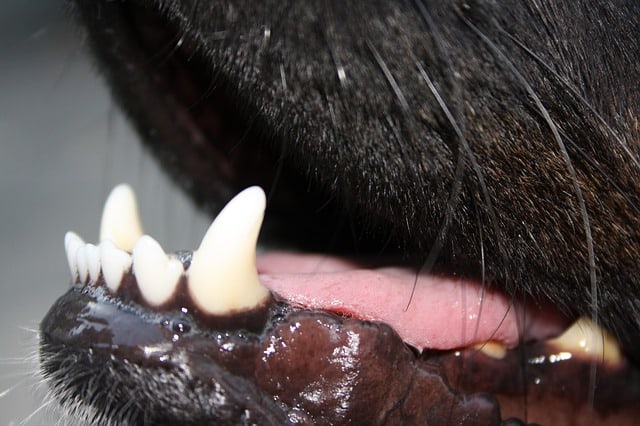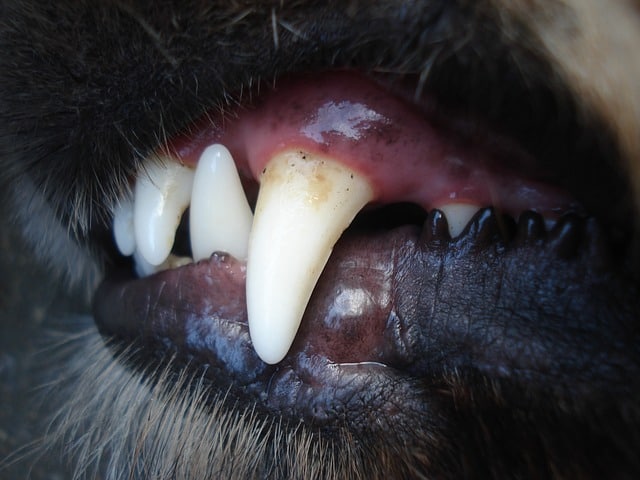Nature is amazing in many ways. It gives each species a defense mechanism to use for protection.
Humans use their fists, voices, weapons, and intelligence to survive in dire situations.
Different animals have various methods of defense including camouflage, emission on killer liquids, playing dead, among other strategies.
For dogs, perhaps the number one protection strategy is biting. No doubt our furry friends know how to use their teeth well when attacked.
Doggies are naturally territorial. They protect their homes from predators such as wolves, lions, and bears.
When their lives or those of their young are in danger, they will rise to the occasion and act aggressively.
Just the sight of a dog growling and biting its strong white teeth can scare you to bits.
Ever wondered how strong your furry friend’s teeth are? We will tell you all about that in this guide.
An Overview of Canine Teeth

If you have ever been a victim of a dog’s bite, you can attest to its power and force.
In a matter of minutes, the teeth will sink into your flesh and tear it apart. Blood will spew in all directions.
If bitten by a Pitbull, better pray he doesn’t lock his jaws because you’d be helpless.
Dogs essentially grow two sets of teeth in their lifetimes just like humans.
At birth, puppies do not have any teeth. However, at around 3-4 weeks of age, 28 deciduous teeth will shoot up from their gums.
These sharp teeth are as sharp as ever. They help the dog explore his surroundings. Milk teeth are also responsible for ripping through your flesh and tearing the house apart.
Related Post: Do Puppies Swallow Their Baby Teeth? (& Other Teething FAQs)
At about 6 months of age, 42 permanent teeth will force their way through the puppy’s gum causing the deciduous teeth to fall out. This is the famous teething stage that dog owners dread.
Like any other creature, a dog’s teeth have living tissue. Each tooth has several layers.
The innermost layer is the core or pup covered by bone. The pulp supplies blood vessels and nerves to the tooth thus keeping it healthy.
Above it is the dentine and finally the enamel (visible part of the tooth).
How Strong Are Your Dog’s Teeth?

Canines have four sets of teeth: 12 incisors, 4 canines, 16 premolars, and ten molars.
When a dog bites, he engages the canines (fangs) only. These are the long teeth on each side of the mouth.
The strength of fangs or what is commonly referred to as the Bite Force is a measure of the force exerted in pounds per square inch.
Different breeds have different bite forces. On average, the number ranges from 250 and 325 PSI for many dogs. However, some surpass this limit by a greater margin.
The Kangal, for instance, has the strongest bite in the world. With a bite force of 734 psi, this Turkish dog can bring down the strongest predators.
Second on the list is the cross between mastiff and bulldog, the Bandog, with a force of 730 psi.
The mastiff comes in the third position with a bite force of 556 psi.
These three breeds are the only ones that have stronger teeth than the wolf. Wolves have a psi clamp of 406 and are considered to be terrorizing.
Other dogs with strong bites include the Rottweiler (328 psi), American bulldog (305 psi), German shepherd (238 psi), American Pitbull (235 psi), Chow chow (220 psi), and Belgian Malinois (195 psi).
Related Posts:
Are dog teeth stronger than humans?

Humans are not too shabby when it comes to the strength of teeth.
We may not bite into tough bones and tear toys apart with our teeth but our chompers are strong in their own rights.
Human babies grow 20 milk teeth. When these fall out, 32 adult teeth will shoot up. This is ten fewer teeth than a dog’s. Still, we have the same number of canines as our pooches.
The human bite force is about 120-220 psi.
If you recall, most doggies range from 250 and 325 psi. This means that dogs have stronger jaws than human beings.
With that said, dog teeth may not be as strong as many people think.
Yes, they can bite into things with incredible force but their enamels are weaker. The canine enamel is actually much thinner than that of humans.
If they chew on hard surfaces, they can easily break their teeth.
So, in a sense, dog’s teeth are great at gripping things, pulling, and lifting. Otherwise, when it comes to crushing stuff, human teeth can handle the force much better.
This is the reason vets recommend against giving dogs cow bones. When buying a chewable toy, it is a good idea to go for something moderately hard.
If it’s too hard, it might cause the enamel to break. Watch out for things like tennis balls, ice cubes, nylon bones, natural bones, and cow hooves.
Related Post: 17 Safe Dog Chews for Aggressive Chewers
Final Thoughts
Dogs have powerful jaws. They can bite with a strong force.
However, when compared to human teeth, canine teeth are much weaker.
Their enamels have fewer layers than those of humans, meaning they can fracture easily.
Image sources: 1, 2, 3, 4
As an Amazon Associate, we may receive a small commission from qualifying purchases but at no extra cost to you. Learn more. Amazon and the Amazon logo are trademarks of Amazon.com, Inc, or its affiliates.

